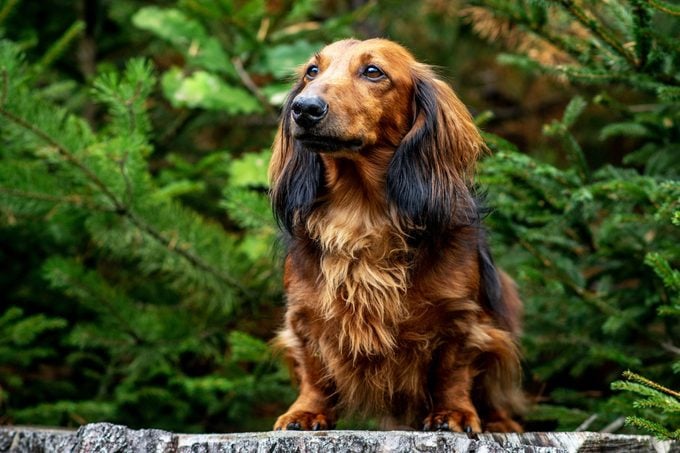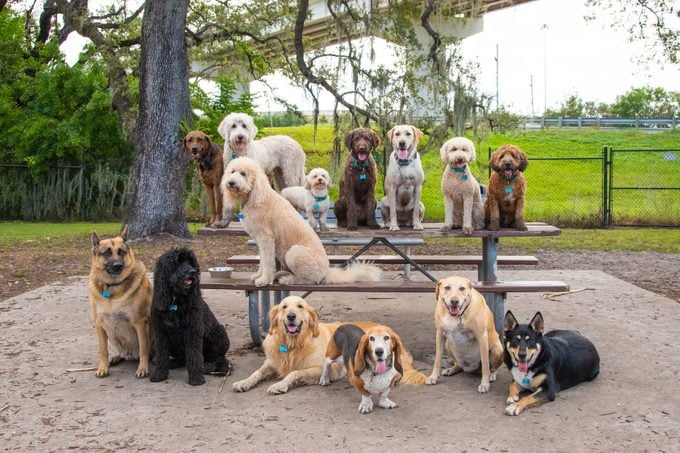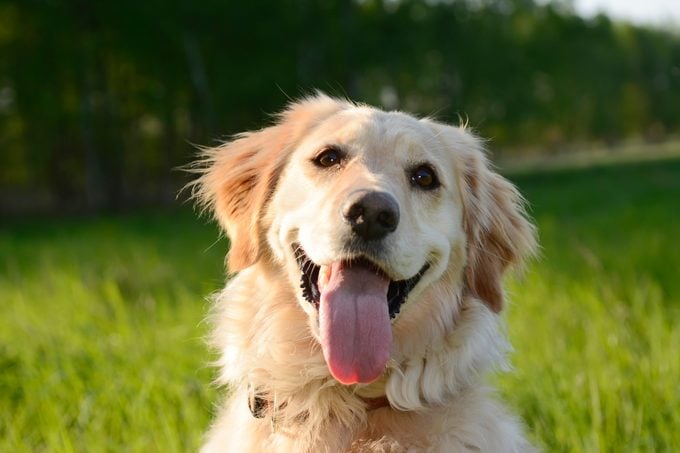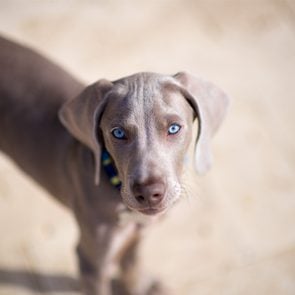The number of dog breeds worldwide isn't straightforward, so let’s put it this way: It’ll be a while before you run out of dogs to adore

How Many Breeds of Dogs Are There in the World?

Have you ever seen an Azawakh or other rare dog breed? If you’re an American Kennel Club (AKC) dog breed aficionado, maybe, but if you’re a more typical dog lover, you’ve probably never heard of most breeds beyond the top 50 or maybe 100 most popular. So just how many breeds of dogs are there?
It’s complicated. It depends on who you ask and how you define a breed. Read on as we explain what dog breeds are, how they’re classified and what it means to be a recognized breed.
Get Reader’s Digest’s Read Up newsletter for more pet insights, cleaning, humor, travel, tech and fun facts all week long.
About the experts
|
What is a breed of dog?

Most people can agree that a breed is a group of multiple generations of domestic animals that are similar enough in appearance (or sometimes function) as a result of selective breeding and genetic isolation.
The Fédération Cynologique Internationale (FCI), the world’s largest dog organization, defines a breed as “a population of dogs sharing definable and inheritable phenotypic characteristics, after breeding undertaken by humans over a given period of time, allowing this population to be distinguished from other defined populations of dogs/or defined breeds.”
A scientist might define a breed differently. Audery Lin, D.Phil., a molecular geneticist interested in domestic animal evolution, says she thinks of a dog breed “as a specific type of domestic dog that was specifically bred by people for a specific cultural function. There may have been different ‘types’ of dogs as long as dogs have been domesticated.”
Lin adds that the concept of distinct breeds is actually fairly recent, “due to the popularity of dog enthusiasts and kennel clubs in the late 19th century that had formalized specific breed standards.”
How about so-called designer dogs? Nope. A breed is not a first-generation cross between other breeds or even second-generation crosses or backcrosses. So a golden doodle, a puggle or a cockapoo, no matter how cute, is not technically a breed.
It was the Victorian-era preoccupation with labeling breeds and splitting animals into categories that gave rise to what we think of as breeds. To this day, what some countries see as a single breed may constitute several breeds in another country. For example, the FCI recognizes the Belgian shepherd as one breed with four coat types. The AKC recognizes each of these coat types as a separate breed (Belgian Laekenois, Belgian Malinois, Belgian sheepdog and Belgian Tervuren). The American Kennel Club sees the dachshund as one breed with three coat varieties and two size categories, while the Canadian Kennel Club considers the dachshund six different breeds.
That’s why, when you ask how many dog breeds there are, it depends on who answers.
How many breeds of dogs are there?

If you ask Dominque De Vito, author of The World Atlas of Dog Breeds, possibly the largest compilation of dog breed descriptions ever made, you get an intriguing reply. She included 425 breeds in her book back in 2009. But even that meant excluding many breeds. “To qualify, the breed had to be registered with an official registering body,” she explains. “Today, the AKC registers 201 breeds and the FCI 360, so the Atlas could have 561 breeds!” And that still wouldn’t be enough.
“A book with every breed? It would need to be a set of encyclopedias by group these days,” says De Vito. After all, her book lists 101 breeds of scent hound (dogs that hunt by scent) alone!
Even the major kennel clubs give different answers if you ask how many dog breeds there are:
- The AKC lists 201 breeds with full recognition.
- The FCI lists 360 breeds.
- The United Kennel Club (UKC), America’s second-largest dog registry, recognizes 376 breeds.
- The Kennel Club in Britain, which is the oldest of any multibreed dog registry, recognizes 222 breeds.
And that’s just a sampling of the more than 100 national kennel clubs around the world, all of which seem to recognize various subsets. For example, the Indian National Kennel Club recognizes the Mudhol hound, the Vietnam Kennel Association the Phu Quoc ridgeback and the Canadian Kennel Club the Karelian bear dog.
Not a single registry recognizes every breed—not even the American Rare Breed Registry (ARBA), which recognizes such breeds as the Alaskan klee kai, king shepherd and Bolognese but still does not include the Rampur hound, Xigou or catalburun, among dozens, maybe hundreds, of others.
But let’s face it: What are the chances of you coming across a Rampur hound outside of India or a Xigou outside of China? For practical purposes, it’s more useful to consider breeds available in the United States if that’s where you live. This is part of why the AKC recognizes breeds only when they have sufficient numbers of dogs and breeders. So what about the Armenian Gampr, Colombian fino hound, Heideterrier, Karakachan, Prague ratter, tornjak and so on? It turns out that although rare, and not AKC-recognized, these breeds do have breeders in the United States and are recognized by some other national kennel clubs. That’s why each of these breeds is listed on America’s major breeder site, Good Dog. In fact, the site features more than 350 breeds, every one represented by an active breeder.
“Good Dog recognizes breeds as purebred if they are recognized by the AKC, FCI or the KC,” says Good Dog spokesperson Cameron Swenson.
How are breeds of dogs classified?

The national clubs even disagree about how to classify their breeds. The AKC classifies them into seven groups:
- Sporting: This group includes dogs that hunt birds, usually along with hunters with guns. It includes pointers, setters, retrievers and spaniels. Some dogs in this group are golden retrievers, cocker spaniels and Irish setters.
- Hound: Dogs in this group hunt mammals either by trailing them using scent (scent hounds) or chasing them using sight (sight hounds). This group includes beagles, greyhounds and Rhodesian ridgebacks.
- Working: The group includes dogs that depend on brawn and guts to do their jobs of guarding, pulling or rescuing. This group includes Siberian huskies, Doberman pinschers, Akitas and boxers.
- Terriers: Dogs bred to kill vermin and pests, as well as bully breeds bred to subdue livestock or fight, find themselves in the terrier group. This includes Airedale terriers, Scottish terriers and bull terriers.
- Toy: The toy group consists of the smallest breeds, often miniaturized versions of large breeds.
- Non-sporting: This is basically a catchall for dogs that don’t fit elsewhere. This group includes Chihuahuas and Yorkshire terriers.
- Herding: The group is made up of breeds that herd or drive livestock. This group includes German shepherds and border collies.
Other kennel clubs use different groupings:
- The UKC divides its breeds into Guardians, Scent hounds, Sight hounds and Pariah dogs, Gun dogs, Northern breeds, Herding, Terriers and Companions.
- The Kennel Club divides breeds into Hound, Working, Terrier, Gun dog, Pastoral, Utility and Toy groups.
- The FCI divides its breeds into 10 groups: Sheepdogs and cattle dogs; Pinschers, schnauzers and molossoids; Terriers; Dachshunds; Spitz and primitive types; Scent hounds; Pointers and setters; Retrievers, flushing dogs and water dogs; Companion and toy dogs; and Sight hounds.
By the way, the AKC reclassifies its breeds and groups on occasion. Back in the 1800s, it started with just Sporting and Non-sporting groups. It split them up as more breeds were added. The last split was in 1984, when the AKC separated the Herding dogs from the Working group. The club considered a major regrouping about a decade ago but didn’t proceed. But many people predict it will have to happen if the AKC continues to recognize more breeds at its current rate.
How does a breed become recognized?
When I first became interested in dogs 50 years ago, the AKC recognized 115 breeds. Rarely, a new breed would be recognized, and we would all flock to see it. My personal claim to fame was being the first to walk into a regular show ring with an Ibizan hound on the first day they were eligible to compete at AKC dog shows. Back then, it was a mystery as to how dogs became recognized.
The first breeds that the AKC recognized, way back in 1878, were the Chesapeake Bay retriever, Clumber spaniel, cocker spaniel, English setter, Gordon setter, Irish setter, Irish water spaniel, pointer and Sussex spaniel. In those days, breeds had to belong to the Sporting group.
Today, the AKC has very clear requirements for breeds looking to join its ranks. And those requirements have become more and more stringent over time. Yet the AKC has become more welcoming overall—the past 10 years have seen a comparative tidal wave, with 23 new breeds receiving full recognition. The club recently welcomed its 201st breed, the Lancashire heeler.
That doesn’t mean you can start breeding doodles with the hope of eventual AKC recognition. In fact, all the major registries explicitly state that a new breed cannot be the result of a direct cross between two already recognized breeds. Nor can it be a nonstandard variation, like a long-coated Frenchie, dwarf Great Dane or merle Weimaraner.
Even if you have a breed that came over on the Mayflower, getting AKC recognition is not easy.
What it takes to become an AKC-recognized breed
First, a dog has to be recorded with an accepted registry, either a recognized kennel club in another country, a national breed club or the AKC’s Foundation Stock Service (FSS). To be accepted into the FSS, a breed must have a documented history going back at least 40 years. It also needs a breed standard, a blueprint outlining the essential features that define the breed’s unique characteristics.
But the first real step toward AKC recognition occurs with entry into the Miscellaneous class, which is like the greenroom for the big-time. And getting accepted is sort of like getting into an Ivy League school. A breed must come with the following credentials:
- A national breed club with at least 100 active household members
- At least 300 to 400 dogs with a three-generation pedigree, all of that breed
- Dogs and club members who live in at least 20 states
- A breed standard that meets the AKC’s approval
That’s just to get into the Miscellaneous class. From there, the AKC keeps tabs on how many dogs and litters are being registered and entered in AKC competitions, plus how well the club has conducted its own competitions and educational opportunities for AKC judges to learn about the breed. Only then will the breed be considered a fully recognized AKC breed.
In case you’re wondering: Yes, this takes a while. On average, breeds spend about three or four years in the Miscellaneous class, but some progress faster (the already-popular Biewer terrier raced through in less than a year) and some move more slowly (the hairless Peruvian Inca Orchid has been there since 2011 and is still waiting).
Kelsey Keefe, director and AKC liaison for the United States Eurasier Club, has been working with other club members to move her breed, the Eurasier, toward AKC recognition. “We’ve been in the FSS since 2008 and are only in Phase 1 of moving forward—we are moving in increments rather deliberately,” she says. “I don’t foresee us having full recognition for at least five to eight years realistically, if not longer, depending on a few moving targets I’m looking at.”
The process can be time-consuming and expensive. “We have been registering our dogs with the Canadian Kennel Club (which already recognizes the Eurasier) since 2000 or so, which means to reach the 150 to 300 dogs needed for full AKC recognition, we need to re-register our CKC dogs as AKC,” she says. Travel and educational materials to promote the breed also add up, especially because breed clubs are all nonprofits, per AKC rules.
“We are trying to stay the course while not abandoning our priorities—the health and well-being and welfare of the dogs themselves,” Keefe says. Fortunately, the dogs don’t care how long it takes. They just want their bellies rubbed.
Why trust us
At Reader’s Digest, we’re committed to producing high-quality content by writers with expertise and experience in their field in consultation with relevant, qualified experts. For this piece, Caroline Coile, PhD, tapped her experience as an award-winning journalist specializing in canine breeds, health and science. We verify all facts and data, back them with credible sourcing and revisit them over time to ensure they remain accurate and up to date. Read more about our team, our contributors and our editorial policies.
Sources:
- Dominique De Vito, author of The World Atlas of Dog Breeds, a former dog book publisher and a former senior editor of the AKC Gazette; internet interview, March 9, 2024
- Kelsey Keefe, director, communications coordinator and AKC liaison for the United States Eurasier Club; internet interview, March 15, 2024
- Audrey Lin, D.Phil., Gerstner Postdoctoral Scholar in bioinformatics and computational biology at the American Museum of Natural History; email interview, March 10, 2024
- Cameron Swenson, spokesperson for Good Dog; email interview, March 12, 2024
- Fédération Cynologique Internationale: “FCI Scientific Commission”























